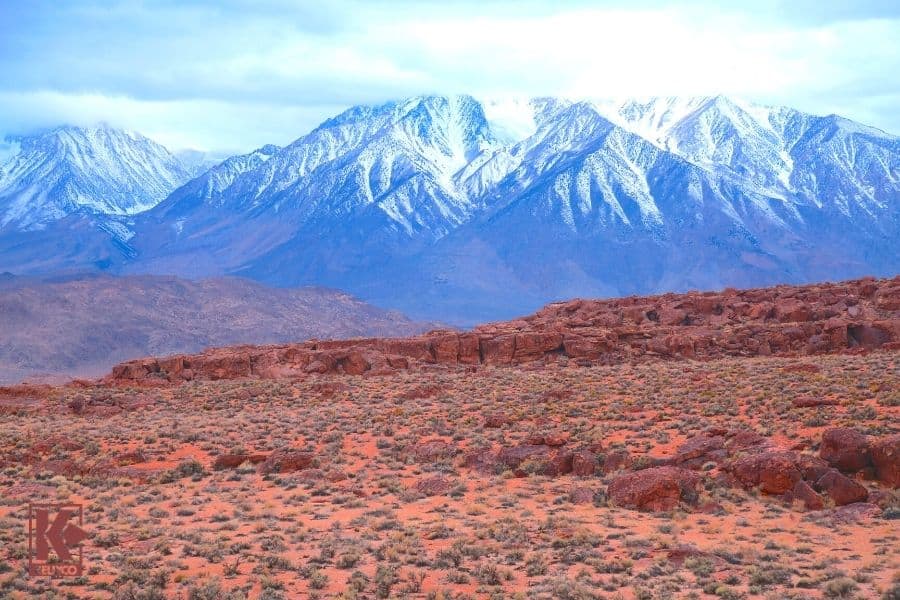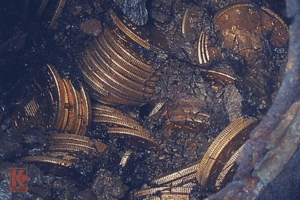The Saddle Ridge Hoard: The $10 Million Mystery
Published by Sam Jacobs on 01/29/21
The biggest buried treasure ever found in the United States was, to put it mildly, nothing to sneeze at: $10 million in the form of over 1,400 gold coins. Known as the Saddle Ridge Hoard, it is shrouded in mystery because no one has any idea who buried the treasure in the first place.
The Ballad of Mary and John

Sierra Madre Mountains
It all started in February 2013 when a Californian couple was taking their dog for a stroll along their property. The woman saw what looked like a tin can sticking up out of the soil. Mary and her husband John then very carefully excavated the tinpot from the earth around it. Once they pulled it out of the ground, their life was changed forever. The couple had found 1,411 gold coins minted between 1847 and 1894. Not only were the coins in good condition, but they also had enough weight to be worth over $10 million.
All told there were eight canisters just filled with gold coins. Not only was this the biggest lost treasure find in American history, but to this day no one has any idea how the gold got there in the first place.
This wasn’t the first strange tin that was found by the couple on their property. There was another tin that had been hanging from a tree for so long that the tree had grown around it. After discovering the first can — which they initially believed contained lead paint because of how heavy it was — the couple returned with a metal detector to see if there was anything else laying around. They were certainly not disappointed as they had discovered an additional seven cans.
Where Did The Gold Come From?
Known as the Saddle Ridge Hoard, we know that it probably was buried on the property sometime at the close of the 19th Century but by whom and for what purpose we will likely never know. Most of the coins came from the San Francisco mint and were from the period of the world-famous California Gold Rush. But some earlier coins from Georgia raise questions about how they got there. It is worth noting that many of the 49’ers of California had previous experience in the Carolina Gold Rush and the Georgia Gold Rush.
The coins weren’t valuable simply because of the weight. They were also valuable because they appear to be in such good condition that they were likely never circulated, giving them a value far beyond their simple weight in gold. The face value of the coins is a scant $28,000, which isn’t a heck of a lot of money today but was a small fortune in the year 1900 — $578,000 in 2020 dollars.

Map of the Sierra Madre Mountains
One popular theory holds that the coins were buried after a 1901 bank heist where a bank employee made off with about $30,000 in gold coins. But the federal government has come out and said that this cannot be the case because the serial numbers on the coins don’t line up with the coins that were stolen.
Others claim that the gold was buried there by a famous outlaw, usually Jesse James or Black Bart, both of whom were known for robbing stagecoaches. The Knights of the Golden Circle are another proposed candidate, with the belief that this was a gold stash with the purpose of starting the Second Civil War.
Another theory is that the coins were put there by a miner who was doing his level best to hide his life’s savings from bandits and other prying eyes. This, however, seems unlikely as many of the coins inside come from after the gold rush was over.
Finally, there is the prevailing theory: A very wealthy person with an intense distrust for banks buried it there and forgot about it. We will likely never have a definitive answer, as both the names of the couple who found it and the location of their gold strike has thus far remained a secret. To this day, all we really know is that the coins were found somewhere in the Sierra Madre Mountains in California, with the recipients of this windfall, perhaps wisely, seeking to keep a low profile. After all, revealing themselves would be an invitation to treasure seekers to flood into the area in search of other tins filled with lost gold from a bygone age.
Of course, a number of people have come forward claiming that the gold belongs to an ancestor or other relative. However, no one has been able to successfully wrest the Saddle Ridge Hoard from the people who initially discovered it.
What Happened to the Saddle Ridge Hoard?

Gold coins found in the Saddle Ridge Hoard
The coins presented a numismatist’s dream because it is very rare to find such a large cache of coins together all in one place. What’s more, as we mentioned, the coins were immaculately preserved despite being, in some cases, over 150 years old.
The coins were sold on Amazon with certificates of authenticity. The couple, known only as Mary and John, were represented by the noted numismatics firm Kagin in their sale of the coins. Prior to selling the coins, the couple kept their find safely stashed away in an old ice chest buried beneath a pile of wood.
Before the discovery of the Saddle Ridge Hoard, the biggest find was a stash of $4,500 in gold coins that sold for a million dollars in 1985. This was found by city workers in Jackson, Tennessee.
Taxes must be paid on such finds, which are considered regular income by the Internal Revenue Service. Still, even taxed as regular income, the take-home pay from a $10 million payday will have the finders sitting pretty for the rest of their lives.
